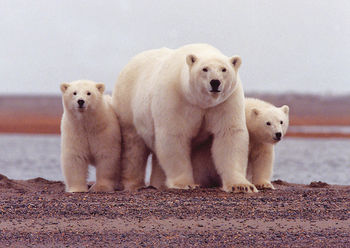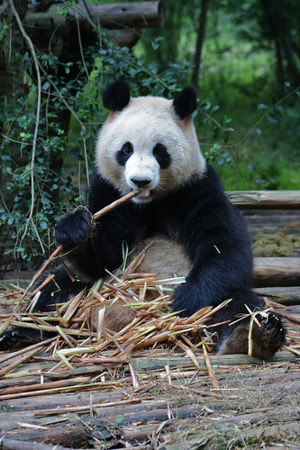Bear (animal): Difference between revisions
Jump to navigation
Jump to search



imported>John Stephenson (Created page with "{{subpages}} <!-- Text is transcluded from the BASEPAGENAME/Definition subpage-->") |
imported>John Stephenson (start) |
||
| Line 1: | Line 1: | ||
{{subpages}} | {{subpages}} | ||
{{Image|Polar-bear-cubs.jpg|right|350px|Female [[polar bear]] and cubs at the [[Beaufort Sea]]. Polar bears are the largest [[species]] of bear.}} | |||
'''Bears''', scientifically classified within the '''[[Ursidae]]''' [[family (biology)|family]], are a group of eight [[mammal]]ian [[species]]. The [[black bear]], [[brown bear]] and [[polar bear]] make up the [[genus]] ''[[Ursus]]'', with the polar bear being the largest species of bear in the world. Bears are carnivorous or omnivorous and [[hibernation|hibernate]] to varying degrees, though the [[Giant Panda]] does not hibernate and eats mostly [[bamboo]]. Bears are found across [[Europe]], [[Asia]], [[North America]] and [[South America]]. | |||
{{Image|Panda.jpg|right|300px|A [[Giant Panda]] eating [[bamboo]] at the [[Chengdu]] Research Base of Giant Panda Breeding, [[Sichuan]] province, [[China]].}} | |||
Revision as of 02:29, 11 April 2012

(CC) Photo: Charles Young
Female polar bear and cubs at the Beaufort Sea. Polar bears are the largest species of bear.
Female polar bear and cubs at the Beaufort Sea. Polar bears are the largest species of bear.
Bears, scientifically classified within the Ursidae family, are a group of eight mammalian species. The black bear, brown bear and polar bear make up the genus Ursus, with the polar bear being the largest species of bear in the world. Bears are carnivorous or omnivorous and hibernate to varying degrees, though the Giant Panda does not hibernate and eats mostly bamboo. Bears are found across Europe, Asia, North America and South America.

(CC) Photo: Richard IJzermans
A Giant Panda eating bamboo at the Chengdu Research Base of Giant Panda Breeding, Sichuan province, China.
A Giant Panda eating bamboo at the Chengdu Research Base of Giant Panda Breeding, Sichuan province, China.